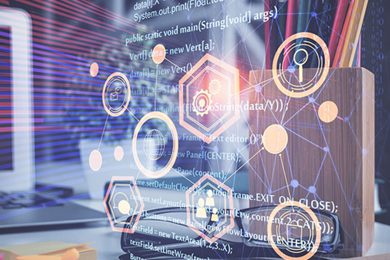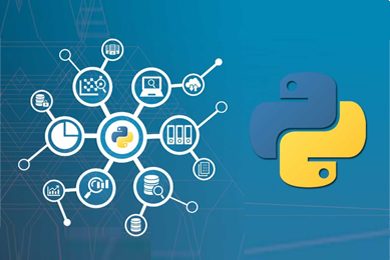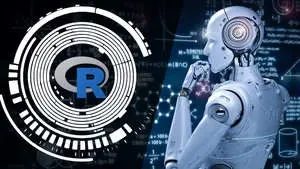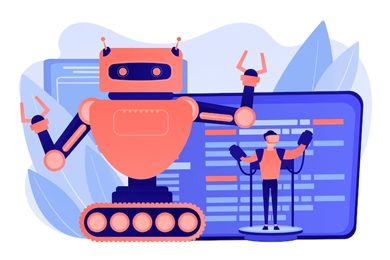This plan includes
- Limited free courses access
- Play & Pause Course Videos
- Video Recorded Lectures
- Learn on Mobile/PC/Tablet
- Quizzes and Real Projects
- Lifetime Course Certificate
- Email & Chat Support
What you'll learn?
- Machine Learning and Data Science using Python for Beginners.
Course Overview
Hi.. Hello and welcome to my new course, Machine Learning with Python for Dummies. We will discuss about the overview of the course and the contents included in this course.
Artificial Intelligence, Machine Learning and Deep Learning Neural Networks are the most used terms now a days in the technology world. It’s also the most mis-understood and confused terms too.
Artificial Intelligence is a broad spectrum of science which tries to make machines intelligent like humans. Machine Learning and Neural Networks are two subsets that comes under this vast machine learning platform
Let’s check what machine is learning now. Just like we human babies, we were actually in our learning phase then. We learned how to crawl, stand, walk, then speak words, then make simple sentences. We learned from our experiences. We had many trials and errors before we learned how to walk and talk. The best trials for walking and talking which gave positive results were kept in our memory and made use later. This process is highly compared to a Machine Learning Mechanism
Then we grew young and started thinking logically about many things, had emotional feelings, etc. We kept on thinking and found solutions to problems in our daily life. That's what the Deep Learning Neural Network Scientists are trying to achieve. A thinking machine.
But in this course we are focusing mainly in Machine Learning. Throughout this course, we are preparing our machine to make it ready for a prediction test. It’s Just like how you prepare for your Mathematics Test in school or college. We learn and train ourselves by solving the most possible number of similar mathematical problems. Let’s call these sample data of similar problems and their solutions as the 'Training Input' and 'Training Output' Respectively. And then the day comes when we have the actual test. We will be given new set of problems to solve, but very similar to the problems we learned, and based on the previous practice and learning experiences, we have to solve them. We can call those problems as 'Testing Input' and our answers as 'Predicted Output'. Later, our professor will evaluate these answers and compare it with its actual answers, we call the actual answers as 'Test Output'. Then a mark will be given on basis of the correct answers. We call this mark as our 'Accuracy'. The life of a machine learning engineer and a data-scientist is dedicated to make this accuracy as good as possible through different techniques and evaluation measures.
Here are the major topics that are included in this course. We are using Python as our programming language. Python is a great tool for the development of programs which perform data analysis and prediction. It has tons of classes and features which perform the complex mathematical analysis and give solutions in simple one or two lines of code so that we don't have to be a statistic genius or mathematical Nerd to learn data science and machine learning. Python really makes things easy.
These are the main topics that are included in our course
System and Environment preparation
-----------------------------------
Installing Python and Required Libraries (Anaconda)
Basics of python and sci-py
---------------------------
Python, Numpy , Matplotlib and Pandas Quick Courses
Load data set from csv / url
-----------------------------
Load CSV data with Python, NumPY and Pandas
Summarize data with description
--------------------------------
Peeking data, Data Dimensions, Data Types, Statistics, Class Distribution, Attribute Correlations, Univariate Skew
Summarize data with visualization
-----------------------------------
Univariate, Multivariate Plots
Prepare data
-------------
Data Transforms, Rescaling, Standardizing, Normalizing and Binarization
Feature selection – Automatic selection techniques
-----------------------------------
Univariate Selection, Recursive Feature Elimination, Principle Component Analysis and Feature Importance
Machine Learning Algorithm Evaluation
-----------------------------------
Train and Test Sets, K-fold Cross Validation, Leave One Out Cross Validation, Repeated Random Test-Train Splits.
Algorithm Evaluation Metrics
-----------------------------
Classification Metrics - Classification Accuracy, Logarithmic Loss, Area Under ROC Curve, Confusion Matrix, Classification Report.
Regression Metrics - Mean Absolute Error, Mean Squared Error, R 2.
Spot-Checking Classification Algorithms
-----------------------------------
Linear Algorithms - Logistic Regression, Linear Discriminant Analysis.
Non-Linear Algorithms - k-Nearest Neighbours, Naive Bayes, Classification and Regression Trees, Support Vector Machines.
Spot-Checking Regression Algorithms
-----------------------------------
Linear Algorithms - Linear Regression, Ridge Regression, LASSO Linear Regression and Elastic Net Regression.
Non-Linear Algorithms - k-Nearest Neighbours, Classification and Regression Trees, Support Vector Machines.
Choose the Best Machine Learning Model
-----------------------------------
Compare Logistic Regression, Linear Discriminant Analysis, k-Nearest Neighbours, Classification and Regression Trees, Naive Bayes, Support Vector Machines.
Automate and Combine Workflows with Pipeline
-----------------------------------
Data Preparation and Modelling Pipeline
Feature Extraction and Modelling Pipeline
Performance Improvement with Ensembles
-----------------------------------
Voting Ensemble
Bagging: Bagged Decision Trees, Random Forest, Extra Trees
Boosting: AdaBoost, Gradient Boosting
Performance Improvement with Algorithm Parameter Tuning
--------------------------------------------------------
Grid Search Parameter
Random Search Parameter Tuning
Save and Load (serialize and deserialize) Machine Learning Models
-----------------------------------
Using pickle
Using Joblib
finalize a machine learning project
-----------------------------------
steps For Finalizing classification models - pima indian dataset
Dealing with imbalanced class problem
steps For Finalizing multi class models - iris flower dataset
steps For Finalizing regression models - boston housing dataset
Predictions and Case Studies
----------------------------
Case study 1: predictions using the Pima Indian Diabetes Dataset
Case study: Iris Flower Multi Class Dataset
Case study 2: the Boston Housing cost Dataset
Machine Learning and Data Science is the most lucrative job in the technology arena now a days. Learning this course will make you equipped to compete in this area.
Best wishes with your learning. See you soon in the class room.
Pre-requisites
- A medium configuration computer and the willingness to indulge in the world of Machine Learning.
Target Audience
- Beginners who are interested in Machine Learning using Python.
Curriculum 88 Lectures 10:04:11
Section 1 : Course Overview _ Table of Contents.
Section 2 : Introduction to Machine Learning.
- Lecture 1 :
- Introduction to Machine Learning - Part 1 - Concepts , Definitions and Types.
- Lecture 2 :
- Introduction to Machine Learning - Part 2 - Classifications and Applications.
Section 3 : System and Environment preparation.
- Lecture 1 :
- System and Environment preparation -Part 1
- Lecture 2 :
- System and Environment preparation -Part 2
Section 4 : Learn Basics of python.
- Lecture 1 :
- Learn Basics of python - Assignment.
- Lecture 2 :
- Learn Basics of python - Flow Control.
- Lecture 3 :
- Learn Basics of python - Functions.
- Lecture 4 :
- Learn Basics of python - Data Structures.
Section 5 : Learn Basics of NumPy.
- Lecture 1 :
- Learn Basics of NumPy - NumPy Array.
- Lecture 2 :
- Learn Basics of NumPy - NumPy Data.
- Lecture 3 :
- Learn Basics of NumPy - NumPy Arithmetic.
Section 6 : Learn Basics of Matplotlib.
- Lecture 1 :
- Learn Basics of Matplotlib.
Section 7 : Learn Basics of Pandas.
- Lecture 1 :
- Learn Basics of Pandas - Part 1
- Lecture 2 :
- Learn Basics of Pandas - Part 2
Section 8 : Understanding the CSV data file.
- Lecture 1 :
- Understanding the CSV data file.
Section 9 : Load and Read CSV data file.
- Lecture 1 :
- Load and Read CSV data file using Python Standard Library.
- Lecture 2 :
- Load and Read CSV data file using NumPy.
- Lecture 3 :
- Load and Read CSV data file using Pandas.
Section 10 : Dataset Summary.
- Lecture 1 :
- Dataset Summary - Peek, Dimensions and Data Types.
- Lecture 2 :
- Dataset Summary - Class Distribution and Data Summary.
- Lecture 3 :
- Dataset Summary - Explaining Correlation.
- Lecture 4 :
- Dataset Summary - Explaining Skewness - Gaussian and Normal Curve.
Section 11 : Dataset Visualization.
- Lecture 1 :
- Dataset Visualization - Using Histograms.
- Lecture 2 :
- Dataset Visualization - Using Density Plots.
- Lecture 3 :
- Dataset Visualization - Box and Whisker Plots.
Section 12 : Multivariate Dataset Visualization.
- Lecture 1 :
- Multivariate Dataset Visualization - Correlation Plots.
- Lecture 2 :
- Multivariate Dataset Visualization - Scatter Plots.
Section 13 : Data Preparation.
- Lecture 1 :
- Data Preparation (Pre-Processing) - Introduction.
- Lecture 2 :
- Data Preparation - Re-scaling Data - Part 2.
- Lecture 3 :
- Data Preparation - Standardizing Data - Part 1.
- Lecture 4 :
- Data Preparation - Standardizing Data - Part 2.
- Lecture 5 :
- Data Preparation - Normalizing Data.
- Lecture 6 :
- Data Preparation - Binarizing Data.
Section 14 : Feature Selection.
- Lecture 1 :
- Feature Selection - Introduction.
- Lecture 2 :
- Feature Selection - Uni-variate Part 1 - Chi-Squared Test.
- Lecture 3 :
- Feature Selection - Uni-variate Part 2 - Chi-Squared Test.
- Lecture 4 :
- Feature Selection - Recursive Feature Elimination.
- Lecture 5 :
- Feature Selection - Principal Component Analysis (PCA).
- Lecture 6 :
- Feature Selection - Feature Importance.
Section 15 : Refresher Session - The Mechanism of Re-sampling, Training and Testing.
- Lecture 1 :
- Refresher Session - The Mechanism of Re-sampling, Training and Testing.
Section 16 : Algorithm Evaluation Techniques.
- Lecture 1 :
- Algorithm Evaluation Techniques - Introduction.
- Lecture 2 :
- Algorithm Evaluation Techniques - Train and Test Set.
- Lecture 3 :
- Algorithm Evaluation Techniques - K-Fold Cross Validation.
- Lecture 4 :
- Algorithm Evaluation Techniques - Leave One Out Cross Validation.
- Lecture 5 :
- Algorithm Evaluation Techniques - Repeated Random Test-Train Splits.
- Lecture 6 :
- Algorithm Evaluation Metrics - Introduction.
- Lecture 7 :
- Algorithm Evaluation Metrics - Classification Accuracy.
- Lecture 8 :
- Algorithm Evaluation Metrics - Log Loss.
- Lecture 9 :
- Algorithm Evaluation Metrics - Area Under ROC Curve.
- Lecture 10 :
- Algorithm Evaluation Metrics - Confusion Matrix.
- Lecture 11 :
- Algorithm Evaluation Metrics - Classification Report.
- Lecture 12 :
- Algorithm Evaluation Metrics - Mean Absolute Error - Dataset Introduction.
- Lecture 13 :
- Algorithm Evaluation Metrics - Mean Absolute Error.
- Lecture 14 :
- Algorithm Evaluation Metrics - Mean Square Error.
- Lecture 15 :
- Algorithm Evaluation Metrics - R Squared.
Section 17 : Classification Algorithm Spot Check.
- Lecture 1 :
- Classification Algorithm Spot Check - Logistic Regression.
- Lecture 2 :
- Classification Algorithm Spot Check - Linear Discriminant Analysis.
- Lecture 3 :
- Classification Algorithm Spot Check - K-Nearest Neighbors.
- Lecture 4 :
- Classification Algorithm Spot Check - Naive Bayes.
- Lecture 5 :
- Classification Algorithm Spot Check - CART.
- Lecture 6 :
- Classification Algorithm Spot Check - Support Vector Machines.
Section 18 : Regression Algorithm Spot Check.
- Lecture 1 :
- Regression Algorithm Spot Check - Linear Regression.
- Lecture 2 :
- Regression Algorithm Spot Check - Ridge Regression.
- Lecture 3 :
- Regression Algorithm Spot Check - LASSO Linear Regression.
- Lecture 4 :
- Regression Algorithm Spot Check - Elastic Net Regression.
- Lecture 5 :
- Regression Algorithm Spot Check - K-Nearest Neighbors.
- Lecture 6 :
- Regression Algorithm Spot Check - CART.
- Lecture 7 :
- Regression Algorithm Spot Check - Support Vector Machines (SVM).
Section 19 : Compare Algorithms, Choosing the best Machine Learning Model.
- Lecture 1 :
- Compare Algorithms - Part 1 Choosing the best Machine Learning Model.
- Lecture 2 :
- Compare Algorithms - Part 2 Choosing the best Machine Learning Model.
Section 20 : Pipelines Data Preparation and Data Modelling.
- Lecture 1 :
- Pipelines Data Preparation and Data Modelling.
Section 21 : Pipelines Feature Selection and Data Modelling.
- Lecture 1 :
- Pipelines Feature Selection and Data Modelling.
Section 22 : Performance Improvement Ensembles.
- Lecture 1 :
- Performance Improvement Ensembles - Voting.
- Lecture 2 :
- Performance Improvement Ensembles - Bagging.
- Lecture 3 :
- Performance Improvement Ensembles - Boosting.
- Lecture 4 :
- Performance Improvement Parameter Tuning using Grid Search.
- Lecture 5 :
- Performance Improvement Parameter Tuning using Random Search.
Section 23 : Export, Save and Load Machine Learning Models.
- Lecture 1 :
- Export, Save and Load Machine Learning Models Pickle.
- Lecture 2 :
- Export, Save and Load Machine Learning Models Joblib.
Section 24 : Finalizing a Model - Introduction and Steps.
- Lecture 1 :
- Finalizing a Model - Introduction and Steps.
Section 25 : Finalizing a Classification Model - The Pima Indian Diabetes Dataset.
- Lecture 1 :
- Finalizing a Classification Model - The Pima Indian Diabetes Dataset.
Section 26 : Quick Session Imbalanced Data Set - Issue Overview and Steps.
- Lecture 1 :
- Quick Session Imbalanced Data Set - Issue Overview and Steps.
Section 27 : Iris Dataset Finalizing Multi-Class Dataset.
- Lecture 1 :
- Iris Dataset Finalizing Multi-Class Dataset.
Section 28 : Finalizing a Regression Model - The Boston Housing Price Dataset.
- Lecture 1 :
- Finalizing a Regression Model - The Boston Housing Price Dataset.
Section 29 : Real-time Predictions Using.
- Lecture 1 :
- Real-time Predictions Using the Pima Indian Diabetes Classification Model.
- Lecture 2 :
- Real-time Predictions Using Iris Flowers Multi-Class Classification Dataset.
- Lecture 3 :
- Real-time Predictions Using the Boston Housing Regression Model.
Our learners work at
Frequently Asked Questions
How do i access the course after purchase?
It's simple. When you sign up, you'll immediately have unlimited viewing of thousands of expert courses, paths to guide your learning, tools to measure your skills and hands-on resources like exercise files. There’s no limit on what you can learn and you can cancel at any time.Are these video based online self-learning courses?
Yes. All of the courses comes with online video based lectures created by certified instructors. Instructors have crafted these courses with a blend of high quality interactive videos, lectures, quizzes & real world projects to give you an indepth knowledge about the topic.Can i play & pause the course as per my convenience?
Yes absolutely & thats one of the advantage of self-paced courses. You can anytime pause or resume the course & come back & forth from one lecture to another lecture, play the videos mulitple times & so on.How do i contact the instructor for any doubts or questions?
Most of these courses have general questions & answers already covered within the course lectures. However, if you need any further help from the instructor, you can use the inbuilt Chat with Instructor option to send a message to an instructor & they will reply you within 24 hours. You can ask as many questions as you want.Do i need a pc to access the course or can i do it on mobile & tablet as well?
Brilliant question? Isn't it? You can access the courses on any device like PC, Mobile, Tablet & even on a smart tv. For mobile & a tablet you can download the Learnfly android or an iOS app. If mobile app is not available in your country, you can access the course directly by visting our website, its fully mobile friendly.Do i get any certificate for the courses?
Yes. Once you complete any course on our platform along with provided assessments by the instructor, you will be eligble to get certificate of course completion.
For how long can i access my course on the platform?
You require an active subscription to access courses on our platform. If your subscription is active, you can access any course on our platform with no restrictions.Is there any free trial?
Currently, we do not offer any free trial.Can i cancel anytime?
Yes, you can cancel your subscription at any time. Your subscription will auto-renew until you cancel, but why would you want to?
Instructor

286710 Course Views
19 Courses



 Tech & IT
Tech & IT
 Business
Business
 Coding & Developer
Coding & Developer
 Finance & Accounting
Finance & Accounting
 Academics
Academics
 Office Applications
Office Applications
 Art & Design
Art & Design
 Marketing
Marketing
 Health & Wellness
Health & Wellness
 Sounds & Music
Sounds & Music
 Lifestyle
Lifestyle
 Photography
Photography


























